Autism Spectrum Disorder: Challenges, Diagnosis and Interventions
VerifiedAdded on 2022/08/27
|35
|11722
|17
Report
AI Summary
This report provides a comprehensive overview of Autism Spectrum Disorder (ASD), emphasizing its impact on communication, social interaction, and behavior. It defines ASD as a lifelong developmental condition characterized by difficulties in making sense of the world and relating to others. The report highlights the importance of early diagnosis and intervention, discussing various challenges faced by individuals with ASD, including communication barriers and social difficulties. It explores diagnostic criteria, emphasizing the need for thorough assessments to differentiate ASD from other conditions. The report also examines different intervention strategies, including psychotherapy, communication techniques, and multidisciplinary care approaches. It stresses the significance of individualized care plans and the role of parents, educators, and healthcare professionals in supporting individuals with ASD throughout their lives. The report underscores the need for a collaborative approach to improve outcomes for individuals with ASD, including the integration of technology and the development of self-management skills.
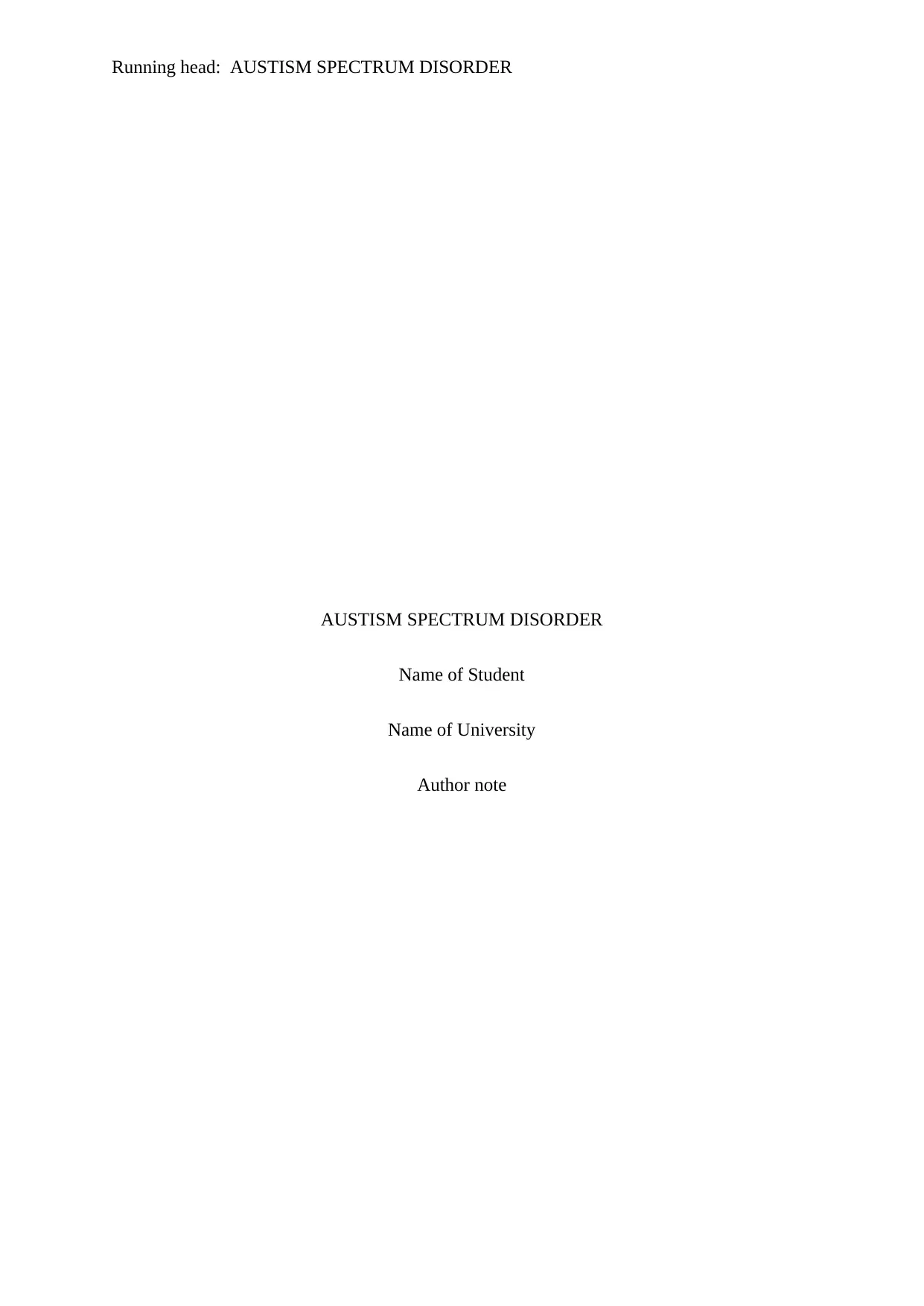
Running head: AUSTISM SPECTRUM DISORDER
AUSTISM SPECTRUM DISORDER
Name of Student
Name of University
Author note
AUSTISM SPECTRUM DISORDER
Name of Student
Name of University
Author note
Paraphrase This Document
Need a fresh take? Get an instant paraphrase of this document with our AI Paraphraser
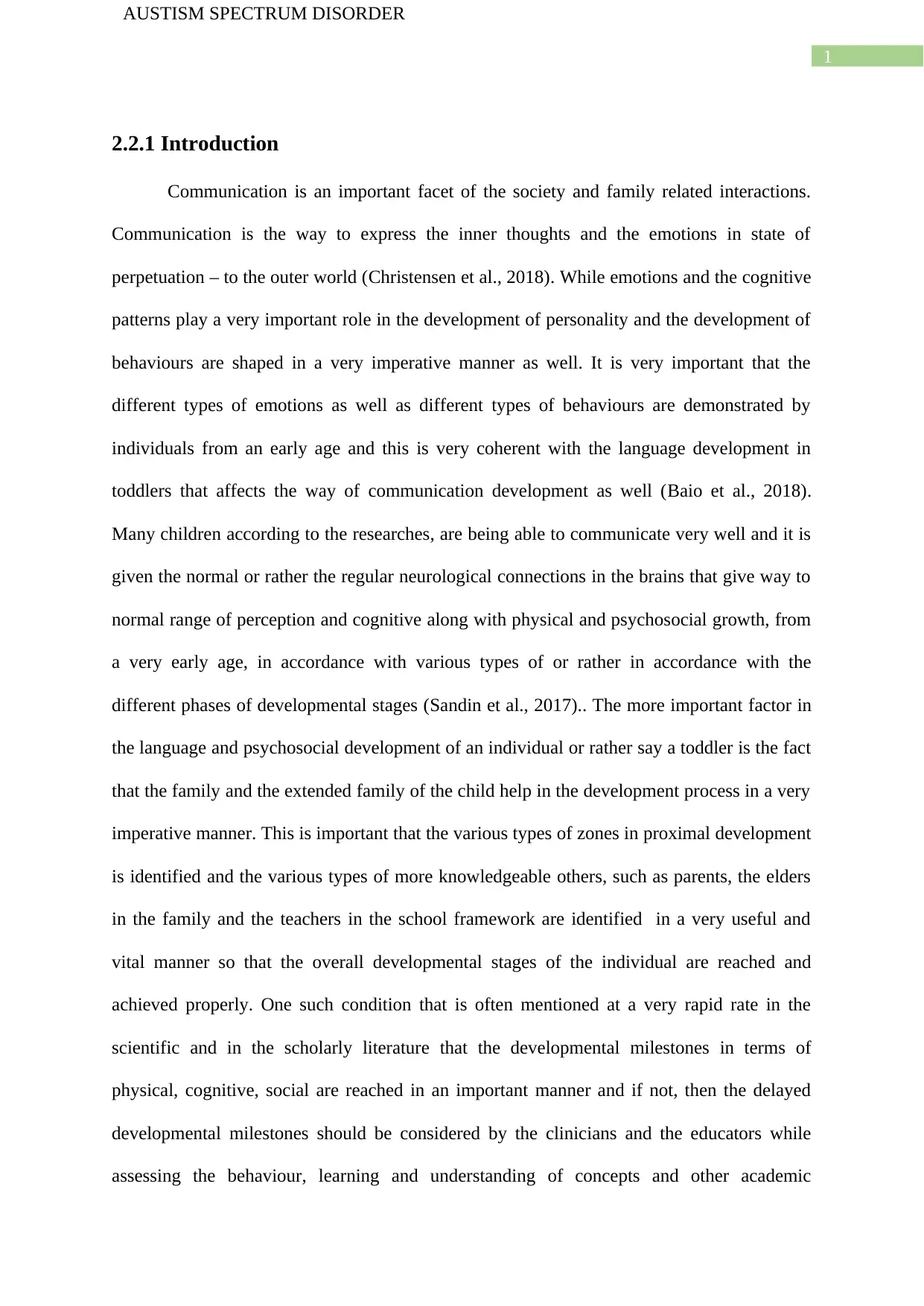
1
AUSTISM SPECTRUM DISORDER
2.2.1 Introduction
Communication is an important facet of the society and family related interactions.
Communication is the way to express the inner thoughts and the emotions in state of
perpetuation – to the outer world (Christensen et al., 2018). While emotions and the cognitive
patterns play a very important role in the development of personality and the development of
behaviours are shaped in a very imperative manner as well. It is very important that the
different types of emotions as well as different types of behaviours are demonstrated by
individuals from an early age and this is very coherent with the language development in
toddlers that affects the way of communication development as well (Baio et al., 2018).
Many children according to the researches, are being able to communicate very well and it is
given the normal or rather the regular neurological connections in the brains that give way to
normal range of perception and cognitive along with physical and psychosocial growth, from
a very early age, in accordance with various types of or rather in accordance with the
different phases of developmental stages (Sandin et al., 2017).. The more important factor in
the language and psychosocial development of an individual or rather say a toddler is the fact
that the family and the extended family of the child help in the development process in a very
imperative manner. This is important that the various types of zones in proximal development
is identified and the various types of more knowledgeable others, such as parents, the elders
in the family and the teachers in the school framework are identified in a very useful and
vital manner so that the overall developmental stages of the individual are reached and
achieved properly. One such condition that is often mentioned at a very rapid rate in the
scientific and in the scholarly literature that the developmental milestones in terms of
physical, cognitive, social are reached in an important manner and if not, then the delayed
developmental milestones should be considered by the clinicians and the educators while
assessing the behaviour, learning and understanding of concepts and other academic
AUSTISM SPECTRUM DISORDER
2.2.1 Introduction
Communication is an important facet of the society and family related interactions.
Communication is the way to express the inner thoughts and the emotions in state of
perpetuation – to the outer world (Christensen et al., 2018). While emotions and the cognitive
patterns play a very important role in the development of personality and the development of
behaviours are shaped in a very imperative manner as well. It is very important that the
different types of emotions as well as different types of behaviours are demonstrated by
individuals from an early age and this is very coherent with the language development in
toddlers that affects the way of communication development as well (Baio et al., 2018).
Many children according to the researches, are being able to communicate very well and it is
given the normal or rather the regular neurological connections in the brains that give way to
normal range of perception and cognitive along with physical and psychosocial growth, from
a very early age, in accordance with various types of or rather in accordance with the
different phases of developmental stages (Sandin et al., 2017).. The more important factor in
the language and psychosocial development of an individual or rather say a toddler is the fact
that the family and the extended family of the child help in the development process in a very
imperative manner. This is important that the various types of zones in proximal development
is identified and the various types of more knowledgeable others, such as parents, the elders
in the family and the teachers in the school framework are identified in a very useful and
vital manner so that the overall developmental stages of the individual are reached and
achieved properly. One such condition that is often mentioned at a very rapid rate in the
scientific and in the scholarly literature that the developmental milestones in terms of
physical, cognitive, social are reached in an important manner and if not, then the delayed
developmental milestones should be considered by the clinicians and the educators while
assessing the behaviour, learning and understanding of concepts and other academic
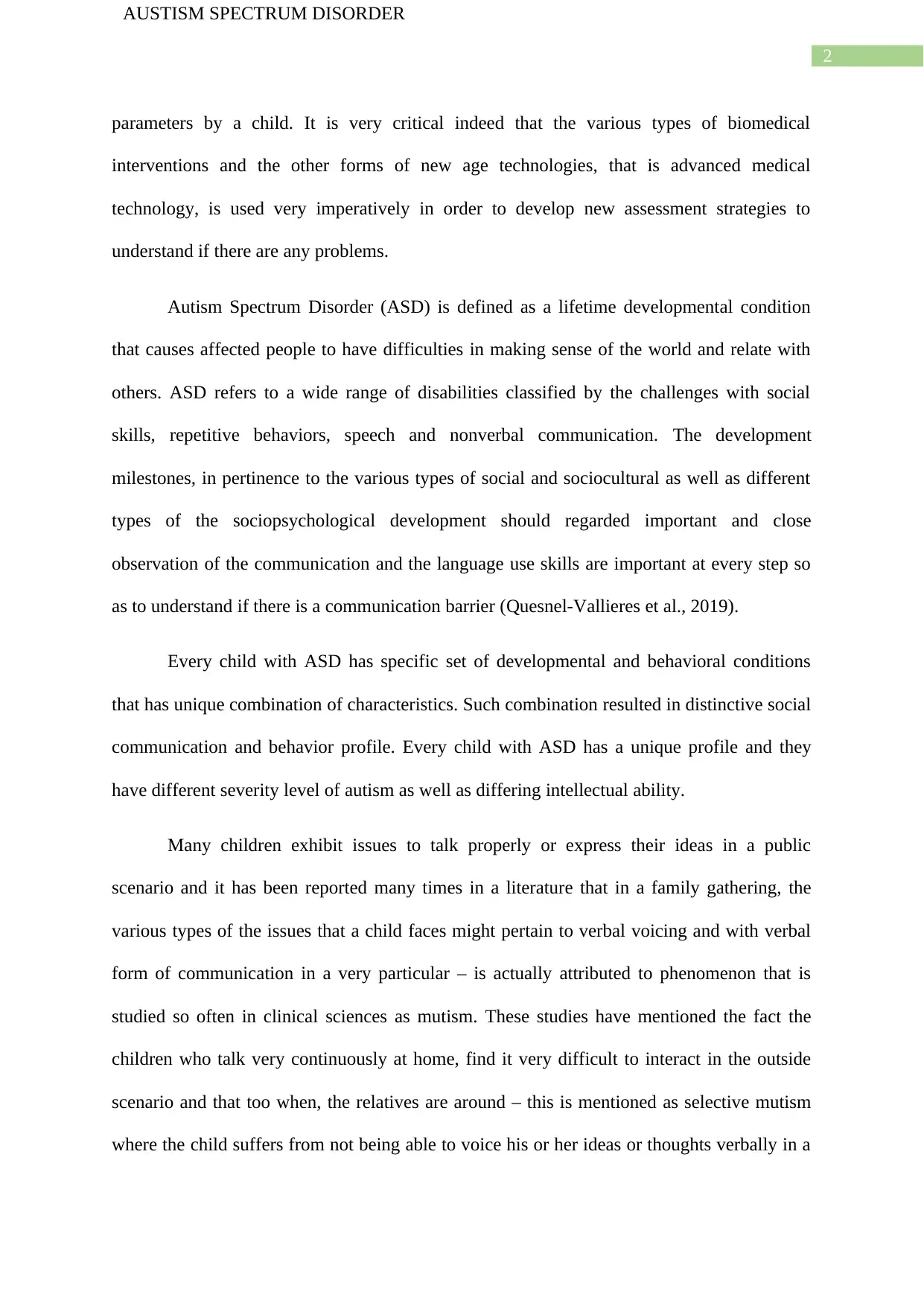
2
AUSTISM SPECTRUM DISORDER
parameters by a child. It is very critical indeed that the various types of biomedical
interventions and the other forms of new age technologies, that is advanced medical
technology, is used very imperatively in order to develop new assessment strategies to
understand if there are any problems.
Autism Spectrum Disorder (ASD) is defined as a lifetime developmental condition
that causes affected people to have difficulties in making sense of the world and relate with
others. ASD refers to a wide range of disabilities classified by the challenges with social
skills, repetitive behaviors, speech and nonverbal communication. The development
milestones, in pertinence to the various types of social and sociocultural as well as different
types of the sociopsychological development should regarded important and close
observation of the communication and the language use skills are important at every step so
as to understand if there is a communication barrier (Quesnel-Vallieres et al., 2019).
Every child with ASD has specific set of developmental and behavioral conditions
that has unique combination of characteristics. Such combination resulted in distinctive social
communication and behavior profile. Every child with ASD has a unique profile and they
have different severity level of autism as well as differing intellectual ability.
Many children exhibit issues to talk properly or express their ideas in a public
scenario and it has been reported many times in a literature that in a family gathering, the
various types of the issues that a child faces might pertain to verbal voicing and with verbal
form of communication in a very particular – is actually attributed to phenomenon that is
studied so often in clinical sciences as mutism. These studies have mentioned the fact the
children who talk very continuously at home, find it very difficult to interact in the outside
scenario and that too when, the relatives are around – this is mentioned as selective mutism
where the child suffers from not being able to voice his or her ideas or thoughts verbally in a
AUSTISM SPECTRUM DISORDER
parameters by a child. It is very critical indeed that the various types of biomedical
interventions and the other forms of new age technologies, that is advanced medical
technology, is used very imperatively in order to develop new assessment strategies to
understand if there are any problems.
Autism Spectrum Disorder (ASD) is defined as a lifetime developmental condition
that causes affected people to have difficulties in making sense of the world and relate with
others. ASD refers to a wide range of disabilities classified by the challenges with social
skills, repetitive behaviors, speech and nonverbal communication. The development
milestones, in pertinence to the various types of social and sociocultural as well as different
types of the sociopsychological development should regarded important and close
observation of the communication and the language use skills are important at every step so
as to understand if there is a communication barrier (Quesnel-Vallieres et al., 2019).
Every child with ASD has specific set of developmental and behavioral conditions
that has unique combination of characteristics. Such combination resulted in distinctive social
communication and behavior profile. Every child with ASD has a unique profile and they
have different severity level of autism as well as differing intellectual ability.
Many children exhibit issues to talk properly or express their ideas in a public
scenario and it has been reported many times in a literature that in a family gathering, the
various types of the issues that a child faces might pertain to verbal voicing and with verbal
form of communication in a very particular – is actually attributed to phenomenon that is
studied so often in clinical sciences as mutism. These studies have mentioned the fact the
children who talk very continuously at home, find it very difficult to interact in the outside
scenario and that too when, the relatives are around – this is mentioned as selective mutism
where the child suffers from not being able to voice his or her ideas or thoughts verbally in a
⊘ This is a preview!⊘
Do you want full access?
Subscribe today to unlock all pages.

Trusted by 1+ million students worldwide
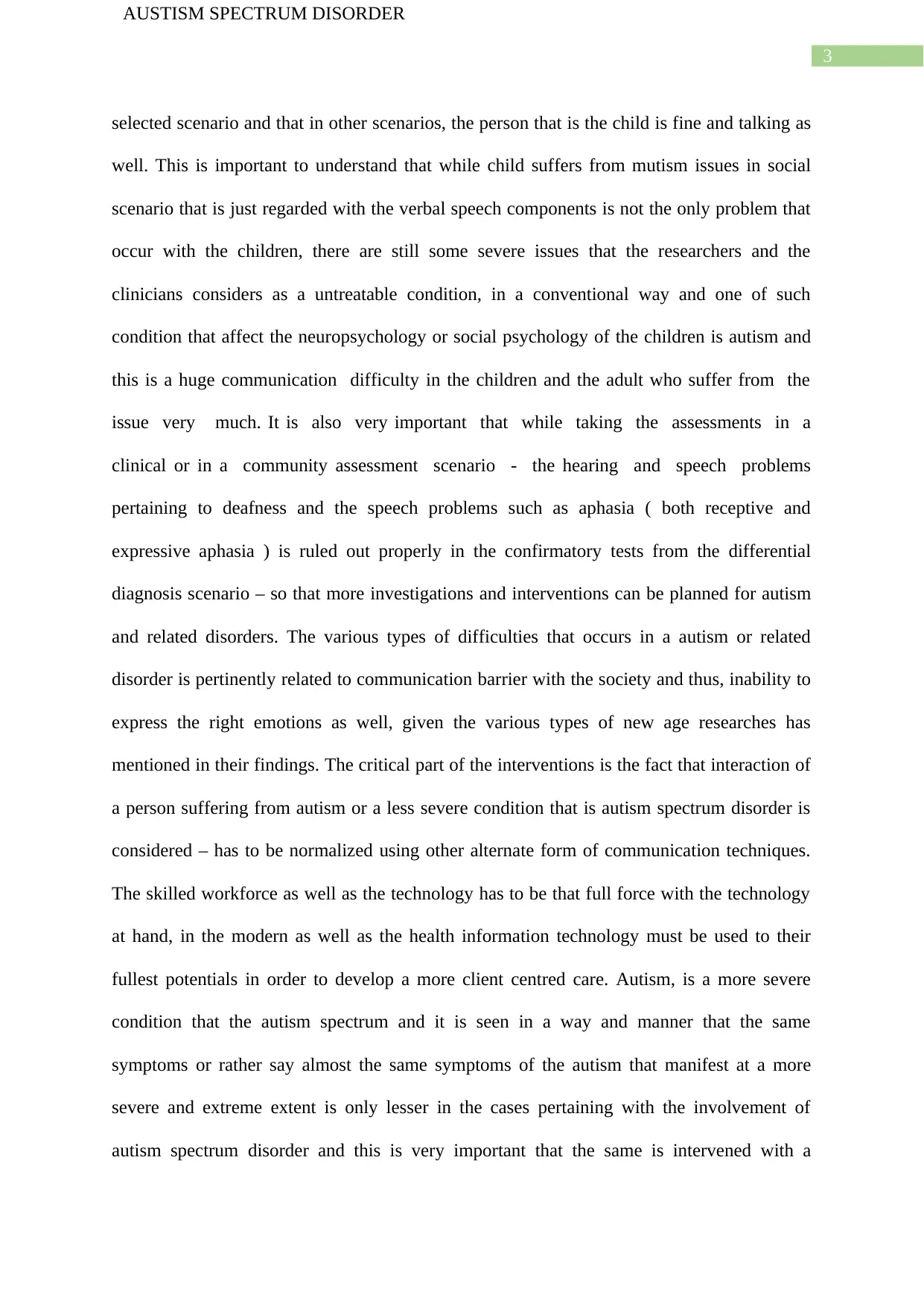
3
AUSTISM SPECTRUM DISORDER
selected scenario and that in other scenarios, the person that is the child is fine and talking as
well. This is important to understand that while child suffers from mutism issues in social
scenario that is just regarded with the verbal speech components is not the only problem that
occur with the children, there are still some severe issues that the researchers and the
clinicians considers as a untreatable condition, in a conventional way and one of such
condition that affect the neuropsychology or social psychology of the children is autism and
this is a huge communication difficulty in the children and the adult who suffer from the
issue very much. It is also very important that while taking the assessments in a
clinical or in a community assessment scenario - the hearing and speech problems
pertaining to deafness and the speech problems such as aphasia ( both receptive and
expressive aphasia ) is ruled out properly in the confirmatory tests from the differential
diagnosis scenario – so that more investigations and interventions can be planned for autism
and related disorders. The various types of difficulties that occurs in a autism or related
disorder is pertinently related to communication barrier with the society and thus, inability to
express the right emotions as well, given the various types of new age researches has
mentioned in their findings. The critical part of the interventions is the fact that interaction of
a person suffering from autism or a less severe condition that is autism spectrum disorder is
considered – has to be normalized using other alternate form of communication techniques.
The skilled workforce as well as the technology has to be that full force with the technology
at hand, in the modern as well as the health information technology must be used to their
fullest potentials in order to develop a more client centred care. Autism, is a more severe
condition that the autism spectrum and it is seen in a way and manner that the same
symptoms or rather say almost the same symptoms of the autism that manifest at a more
severe and extreme extent is only lesser in the cases pertaining with the involvement of
autism spectrum disorder and this is very important that the same is intervened with a
AUSTISM SPECTRUM DISORDER
selected scenario and that in other scenarios, the person that is the child is fine and talking as
well. This is important to understand that while child suffers from mutism issues in social
scenario that is just regarded with the verbal speech components is not the only problem that
occur with the children, there are still some severe issues that the researchers and the
clinicians considers as a untreatable condition, in a conventional way and one of such
condition that affect the neuropsychology or social psychology of the children is autism and
this is a huge communication difficulty in the children and the adult who suffer from the
issue very much. It is also very important that while taking the assessments in a
clinical or in a community assessment scenario - the hearing and speech problems
pertaining to deafness and the speech problems such as aphasia ( both receptive and
expressive aphasia ) is ruled out properly in the confirmatory tests from the differential
diagnosis scenario – so that more investigations and interventions can be planned for autism
and related disorders. The various types of difficulties that occurs in a autism or related
disorder is pertinently related to communication barrier with the society and thus, inability to
express the right emotions as well, given the various types of new age researches has
mentioned in their findings. The critical part of the interventions is the fact that interaction of
a person suffering from autism or a less severe condition that is autism spectrum disorder is
considered – has to be normalized using other alternate form of communication techniques.
The skilled workforce as well as the technology has to be that full force with the technology
at hand, in the modern as well as the health information technology must be used to their
fullest potentials in order to develop a more client centred care. Autism, is a more severe
condition that the autism spectrum and it is seen in a way and manner that the same
symptoms or rather say almost the same symptoms of the autism that manifest at a more
severe and extreme extent is only lesser in the cases pertaining with the involvement of
autism spectrum disorder and this is very important that the same is intervened with a
Paraphrase This Document
Need a fresh take? Get an instant paraphrase of this document with our AI Paraphraser
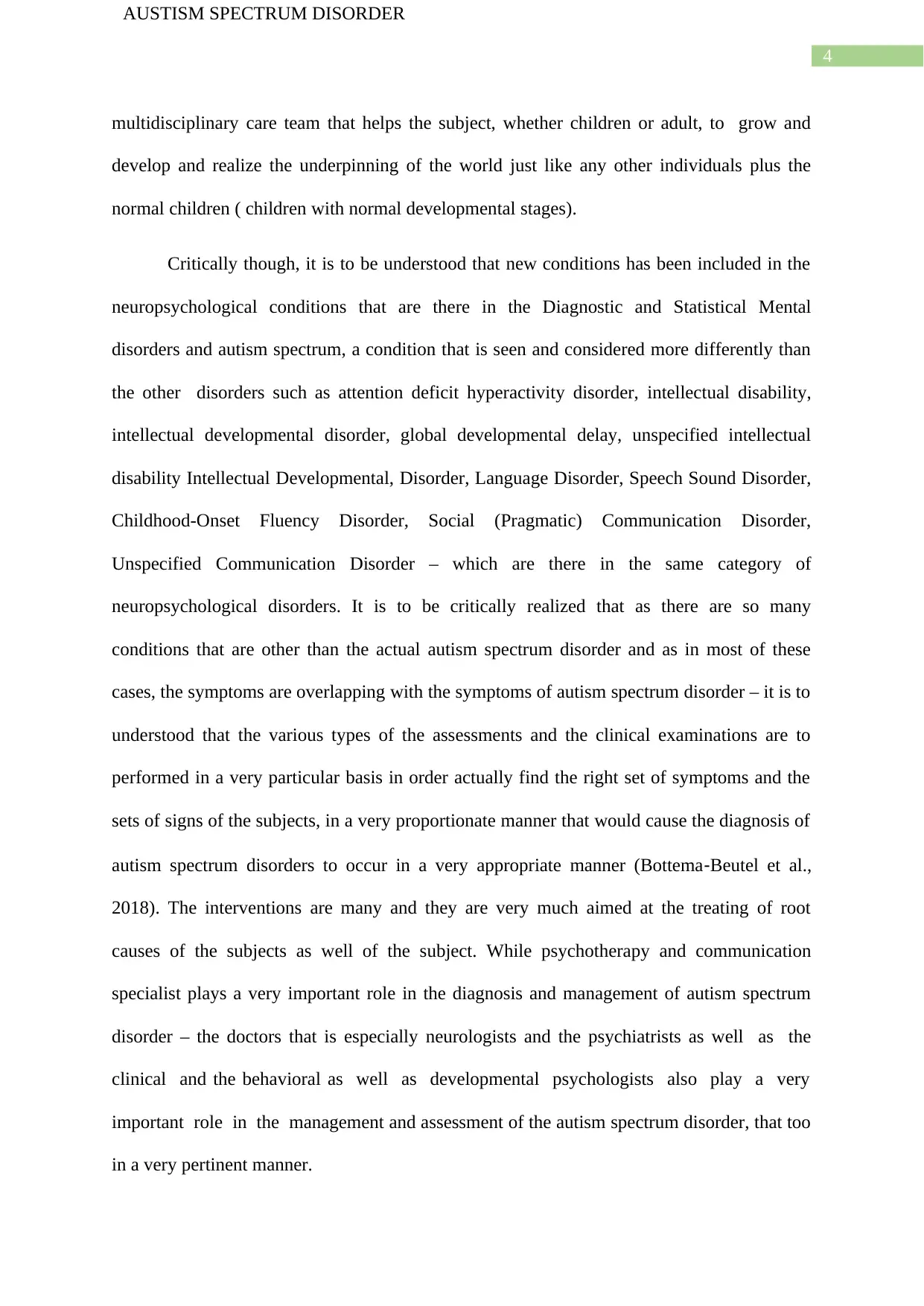
4
AUSTISM SPECTRUM DISORDER
multidisciplinary care team that helps the subject, whether children or adult, to grow and
develop and realize the underpinning of the world just like any other individuals plus the
normal children ( children with normal developmental stages).
Critically though, it is to be understood that new conditions has been included in the
neuropsychological conditions that are there in the Diagnostic and Statistical Mental
disorders and autism spectrum, a condition that is seen and considered more differently than
the other disorders such as attention deficit hyperactivity disorder, intellectual disability,
intellectual developmental disorder, global developmental delay, unspecified intellectual
disability Intellectual Developmental, Disorder, Language Disorder, Speech Sound Disorder,
Childhood-Onset Fluency Disorder, Social (Pragmatic) Communication Disorder,
Unspecified Communication Disorder – which are there in the same category of
neuropsychological disorders. It is to be critically realized that as there are so many
conditions that are other than the actual autism spectrum disorder and as in most of these
cases, the symptoms are overlapping with the symptoms of autism spectrum disorder – it is to
understood that the various types of the assessments and the clinical examinations are to
performed in a very particular basis in order actually find the right set of symptoms and the
sets of signs of the subjects, in a very proportionate manner that would cause the diagnosis of
autism spectrum disorders to occur in a very appropriate manner (Bottema‐Beutel et al.,
2018). The interventions are many and they are very much aimed at the treating of root
causes of the subjects as well of the subject. While psychotherapy and communication
specialist plays a very important role in the diagnosis and management of autism spectrum
disorder – the doctors that is especially neurologists and the psychiatrists as well as the
clinical and the behavioral as well as developmental psychologists also play a very
important role in the management and assessment of the autism spectrum disorder, that too
in a very pertinent manner.
AUSTISM SPECTRUM DISORDER
multidisciplinary care team that helps the subject, whether children or adult, to grow and
develop and realize the underpinning of the world just like any other individuals plus the
normal children ( children with normal developmental stages).
Critically though, it is to be understood that new conditions has been included in the
neuropsychological conditions that are there in the Diagnostic and Statistical Mental
disorders and autism spectrum, a condition that is seen and considered more differently than
the other disorders such as attention deficit hyperactivity disorder, intellectual disability,
intellectual developmental disorder, global developmental delay, unspecified intellectual
disability Intellectual Developmental, Disorder, Language Disorder, Speech Sound Disorder,
Childhood-Onset Fluency Disorder, Social (Pragmatic) Communication Disorder,
Unspecified Communication Disorder – which are there in the same category of
neuropsychological disorders. It is to be critically realized that as there are so many
conditions that are other than the actual autism spectrum disorder and as in most of these
cases, the symptoms are overlapping with the symptoms of autism spectrum disorder – it is to
understood that the various types of the assessments and the clinical examinations are to
performed in a very particular basis in order actually find the right set of symptoms and the
sets of signs of the subjects, in a very proportionate manner that would cause the diagnosis of
autism spectrum disorders to occur in a very appropriate manner (Bottema‐Beutel et al.,
2018). The interventions are many and they are very much aimed at the treating of root
causes of the subjects as well of the subject. While psychotherapy and communication
specialist plays a very important role in the diagnosis and management of autism spectrum
disorder – the doctors that is especially neurologists and the psychiatrists as well as the
clinical and the behavioral as well as developmental psychologists also play a very
important role in the management and assessment of the autism spectrum disorder, that too
in a very pertinent manner.
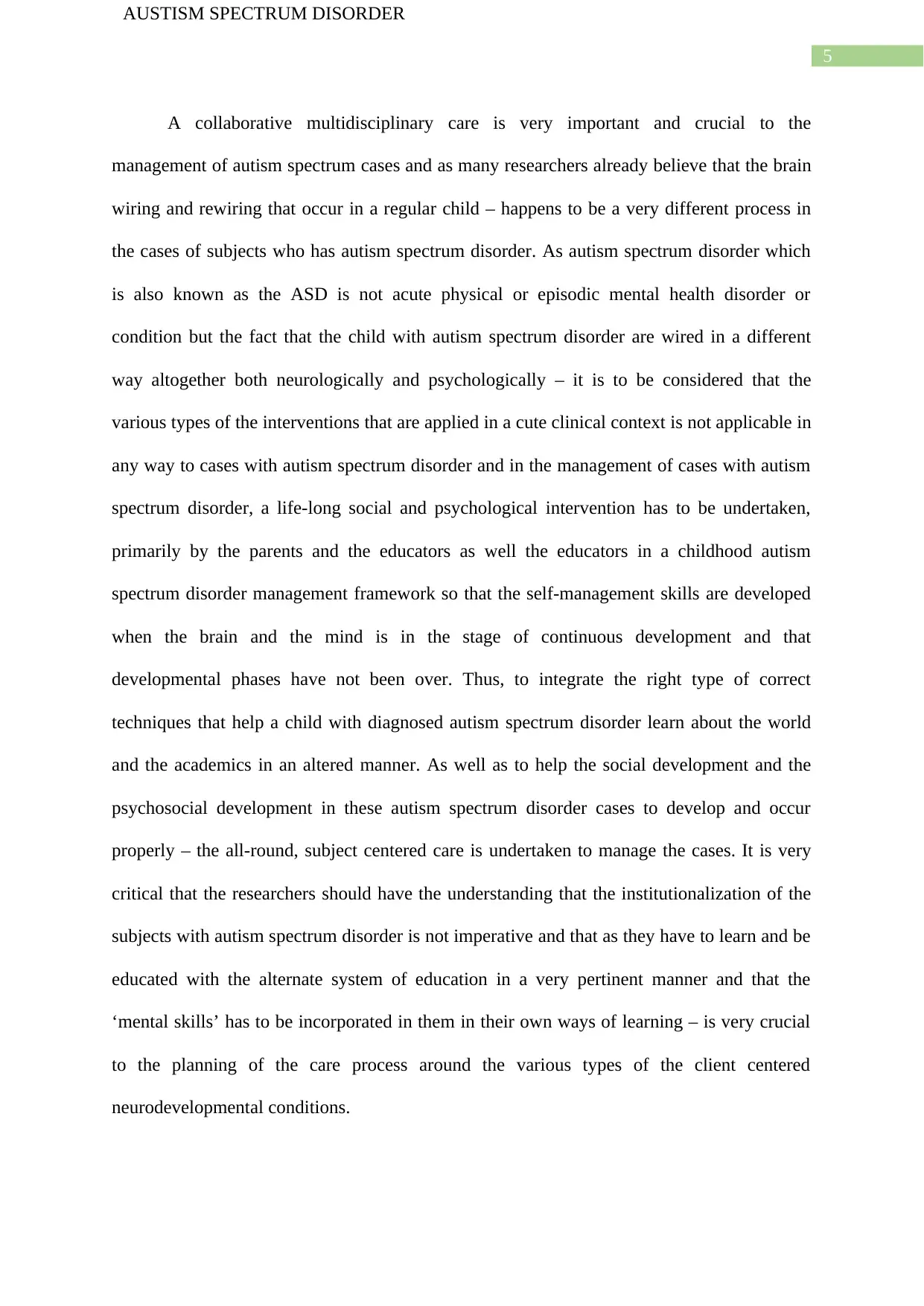
5
AUSTISM SPECTRUM DISORDER
A collaborative multidisciplinary care is very important and crucial to the
management of autism spectrum cases and as many researchers already believe that the brain
wiring and rewiring that occur in a regular child – happens to be a very different process in
the cases of subjects who has autism spectrum disorder. As autism spectrum disorder which
is also known as the ASD is not acute physical or episodic mental health disorder or
condition but the fact that the child with autism spectrum disorder are wired in a different
way altogether both neurologically and psychologically – it is to be considered that the
various types of the interventions that are applied in a cute clinical context is not applicable in
any way to cases with autism spectrum disorder and in the management of cases with autism
spectrum disorder, a life-long social and psychological intervention has to be undertaken,
primarily by the parents and the educators as well the educators in a childhood autism
spectrum disorder management framework so that the self-management skills are developed
when the brain and the mind is in the stage of continuous development and that
developmental phases have not been over. Thus, to integrate the right type of correct
techniques that help a child with diagnosed autism spectrum disorder learn about the world
and the academics in an altered manner. As well as to help the social development and the
psychosocial development in these autism spectrum disorder cases to develop and occur
properly – the all-round, subject centered care is undertaken to manage the cases. It is very
critical that the researchers should have the understanding that the institutionalization of the
subjects with autism spectrum disorder is not imperative and that as they have to learn and be
educated with the alternate system of education in a very pertinent manner and that the
‘mental skills’ has to be incorporated in them in their own ways of learning – is very crucial
to the planning of the care process around the various types of the client centered
neurodevelopmental conditions.
AUSTISM SPECTRUM DISORDER
A collaborative multidisciplinary care is very important and crucial to the
management of autism spectrum cases and as many researchers already believe that the brain
wiring and rewiring that occur in a regular child – happens to be a very different process in
the cases of subjects who has autism spectrum disorder. As autism spectrum disorder which
is also known as the ASD is not acute physical or episodic mental health disorder or
condition but the fact that the child with autism spectrum disorder are wired in a different
way altogether both neurologically and psychologically – it is to be considered that the
various types of the interventions that are applied in a cute clinical context is not applicable in
any way to cases with autism spectrum disorder and in the management of cases with autism
spectrum disorder, a life-long social and psychological intervention has to be undertaken,
primarily by the parents and the educators as well the educators in a childhood autism
spectrum disorder management framework so that the self-management skills are developed
when the brain and the mind is in the stage of continuous development and that
developmental phases have not been over. Thus, to integrate the right type of correct
techniques that help a child with diagnosed autism spectrum disorder learn about the world
and the academics in an altered manner. As well as to help the social development and the
psychosocial development in these autism spectrum disorder cases to develop and occur
properly – the all-round, subject centered care is undertaken to manage the cases. It is very
critical that the researchers should have the understanding that the institutionalization of the
subjects with autism spectrum disorder is not imperative and that as they have to learn and be
educated with the alternate system of education in a very pertinent manner and that the
‘mental skills’ has to be incorporated in them in their own ways of learning – is very crucial
to the planning of the care process around the various types of the client centered
neurodevelopmental conditions.
⊘ This is a preview!⊘
Do you want full access?
Subscribe today to unlock all pages.

Trusted by 1+ million students worldwide
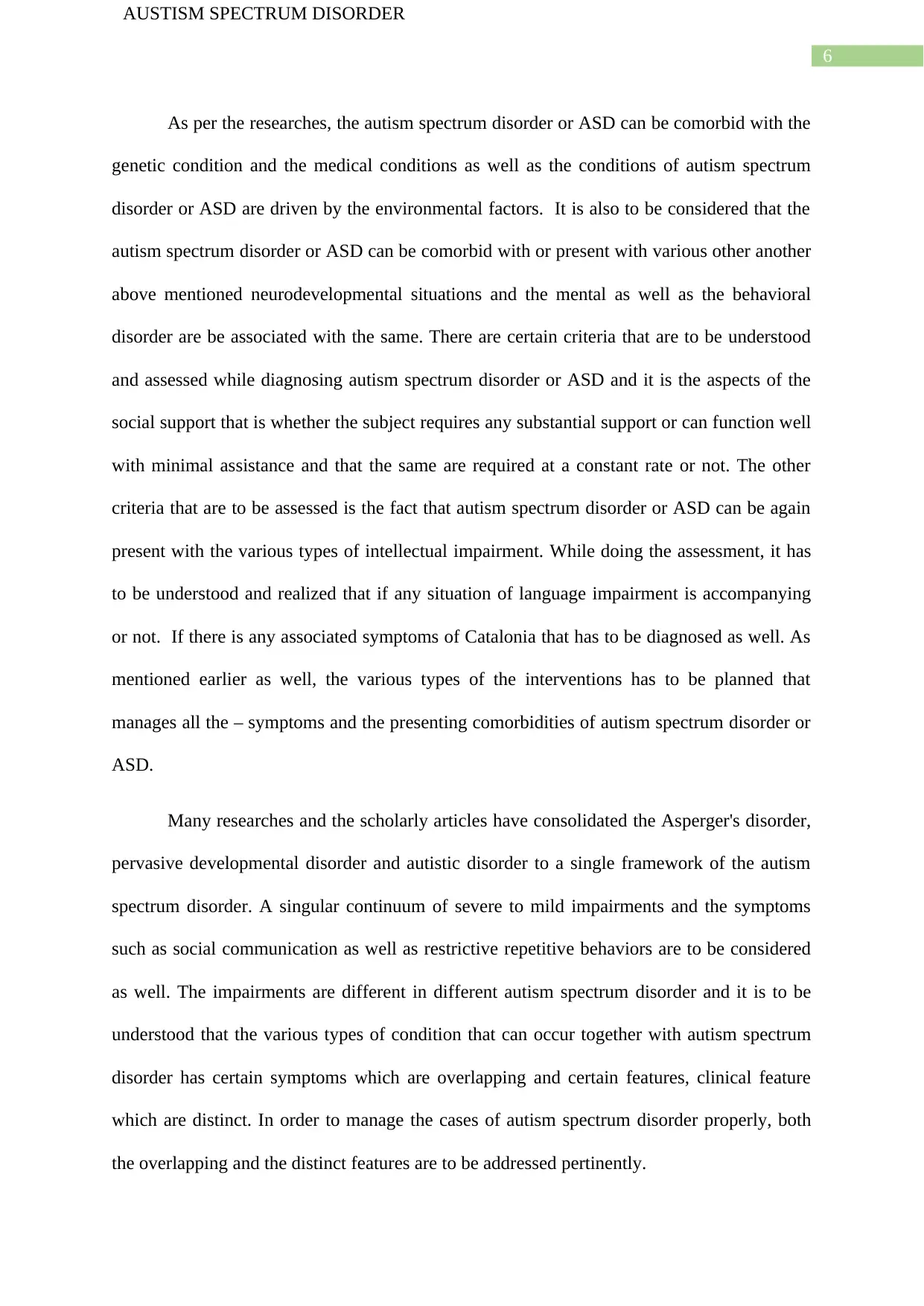
6
AUSTISM SPECTRUM DISORDER
As per the researches, the autism spectrum disorder or ASD can be comorbid with the
genetic condition and the medical conditions as well as the conditions of autism spectrum
disorder or ASD are driven by the environmental factors. It is also to be considered that the
autism spectrum disorder or ASD can be comorbid with or present with various other another
above mentioned neurodevelopmental situations and the mental as well as the behavioral
disorder are be associated with the same. There are certain criteria that are to be understood
and assessed while diagnosing autism spectrum disorder or ASD and it is the aspects of the
social support that is whether the subject requires any substantial support or can function well
with minimal assistance and that the same are required at a constant rate or not. The other
criteria that are to be assessed is the fact that autism spectrum disorder or ASD can be again
present with the various types of intellectual impairment. While doing the assessment, it has
to be understood and realized that if any situation of language impairment is accompanying
or not. If there is any associated symptoms of Catalonia that has to be diagnosed as well. As
mentioned earlier as well, the various types of the interventions has to be planned that
manages all the – symptoms and the presenting comorbidities of autism spectrum disorder or
ASD.
Many researches and the scholarly articles have consolidated the Asperger's disorder,
pervasive developmental disorder and autistic disorder to a single framework of the autism
spectrum disorder. A singular continuum of severe to mild impairments and the symptoms
such as social communication as well as restrictive repetitive behaviors are to be considered
as well. The impairments are different in different autism spectrum disorder and it is to be
understood that the various types of condition that can occur together with autism spectrum
disorder has certain symptoms which are overlapping and certain features, clinical feature
which are distinct. In order to manage the cases of autism spectrum disorder properly, both
the overlapping and the distinct features are to be addressed pertinently.
AUSTISM SPECTRUM DISORDER
As per the researches, the autism spectrum disorder or ASD can be comorbid with the
genetic condition and the medical conditions as well as the conditions of autism spectrum
disorder or ASD are driven by the environmental factors. It is also to be considered that the
autism spectrum disorder or ASD can be comorbid with or present with various other another
above mentioned neurodevelopmental situations and the mental as well as the behavioral
disorder are be associated with the same. There are certain criteria that are to be understood
and assessed while diagnosing autism spectrum disorder or ASD and it is the aspects of the
social support that is whether the subject requires any substantial support or can function well
with minimal assistance and that the same are required at a constant rate or not. The other
criteria that are to be assessed is the fact that autism spectrum disorder or ASD can be again
present with the various types of intellectual impairment. While doing the assessment, it has
to be understood and realized that if any situation of language impairment is accompanying
or not. If there is any associated symptoms of Catalonia that has to be diagnosed as well. As
mentioned earlier as well, the various types of the interventions has to be planned that
manages all the – symptoms and the presenting comorbidities of autism spectrum disorder or
ASD.
Many researches and the scholarly articles have consolidated the Asperger's disorder,
pervasive developmental disorder and autistic disorder to a single framework of the autism
spectrum disorder. A singular continuum of severe to mild impairments and the symptoms
such as social communication as well as restrictive repetitive behaviors are to be considered
as well. The impairments are different in different autism spectrum disorder and it is to be
understood that the various types of condition that can occur together with autism spectrum
disorder has certain symptoms which are overlapping and certain features, clinical feature
which are distinct. In order to manage the cases of autism spectrum disorder properly, both
the overlapping and the distinct features are to be addressed pertinently.
Paraphrase This Document
Need a fresh take? Get an instant paraphrase of this document with our AI Paraphraser
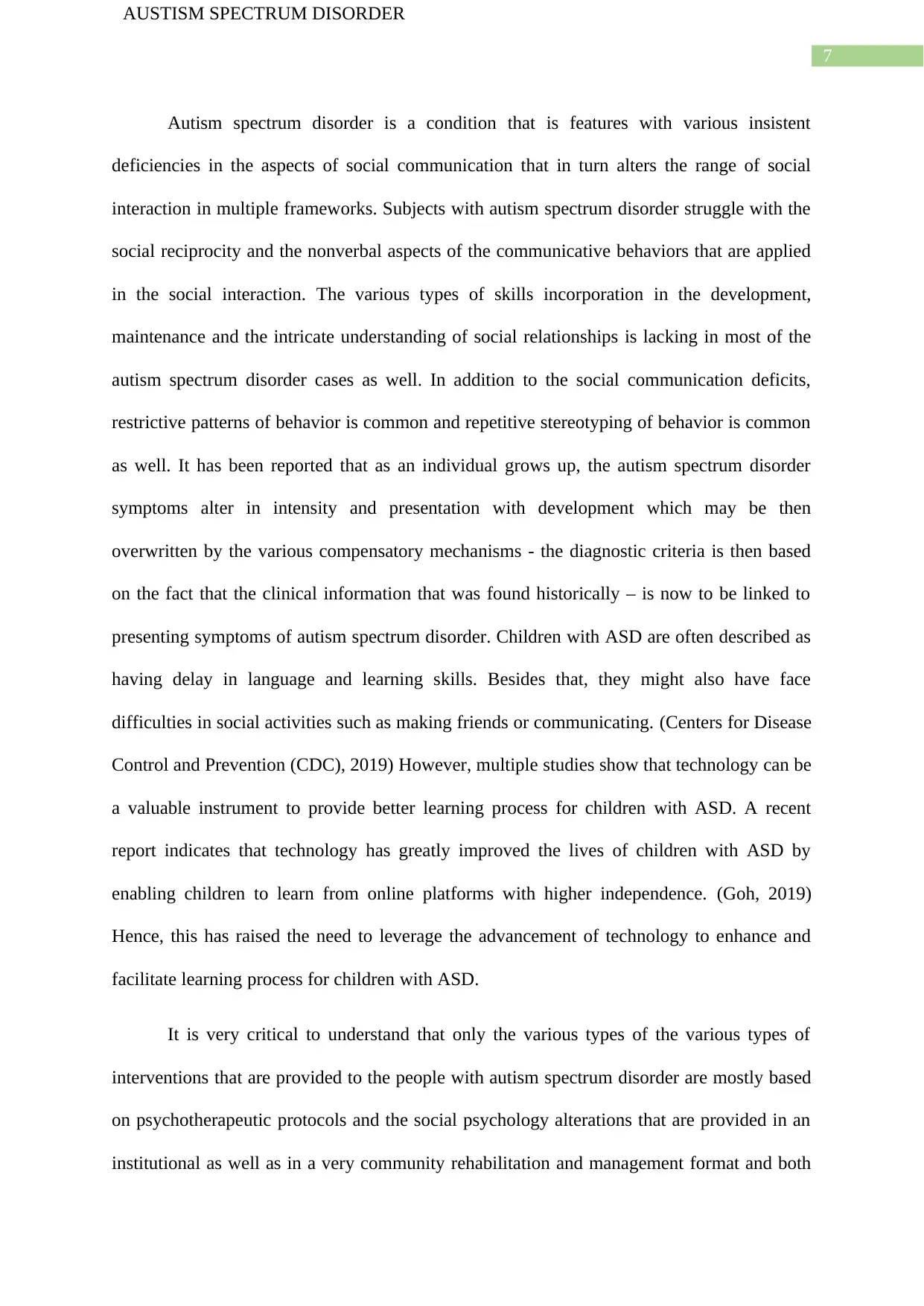
7
AUSTISM SPECTRUM DISORDER
Autism spectrum disorder is a condition that is features with various insistent
deficiencies in the aspects of social communication that in turn alters the range of social
interaction in multiple frameworks. Subjects with autism spectrum disorder struggle with the
social reciprocity and the nonverbal aspects of the communicative behaviors that are applied
in the social interaction. The various types of skills incorporation in the development,
maintenance and the intricate understanding of social relationships is lacking in most of the
autism spectrum disorder cases as well. In addition to the social communication deficits,
restrictive patterns of behavior is common and repetitive stereotyping of behavior is common
as well. It has been reported that as an individual grows up, the autism spectrum disorder
symptoms alter in intensity and presentation with development which may be then
overwritten by the various compensatory mechanisms - the diagnostic criteria is then based
on the fact that the clinical information that was found historically – is now to be linked to
presenting symptoms of autism spectrum disorder. Children with ASD are often described as
having delay in language and learning skills. Besides that, they might also have face
difficulties in social activities such as making friends or communicating. (Centers for Disease
Control and Prevention (CDC), 2019) However, multiple studies show that technology can be
a valuable instrument to provide better learning process for children with ASD. A recent
report indicates that technology has greatly improved the lives of children with ASD by
enabling children to learn from online platforms with higher independence. (Goh, 2019)
Hence, this has raised the need to leverage the advancement of technology to enhance and
facilitate learning process for children with ASD.
It is very critical to understand that only the various types of the various types of
interventions that are provided to the people with autism spectrum disorder are mostly based
on psychotherapeutic protocols and the social psychology alterations that are provided in an
institutional as well as in a very community rehabilitation and management format and both
AUSTISM SPECTRUM DISORDER
Autism spectrum disorder is a condition that is features with various insistent
deficiencies in the aspects of social communication that in turn alters the range of social
interaction in multiple frameworks. Subjects with autism spectrum disorder struggle with the
social reciprocity and the nonverbal aspects of the communicative behaviors that are applied
in the social interaction. The various types of skills incorporation in the development,
maintenance and the intricate understanding of social relationships is lacking in most of the
autism spectrum disorder cases as well. In addition to the social communication deficits,
restrictive patterns of behavior is common and repetitive stereotyping of behavior is common
as well. It has been reported that as an individual grows up, the autism spectrum disorder
symptoms alter in intensity and presentation with development which may be then
overwritten by the various compensatory mechanisms - the diagnostic criteria is then based
on the fact that the clinical information that was found historically – is now to be linked to
presenting symptoms of autism spectrum disorder. Children with ASD are often described as
having delay in language and learning skills. Besides that, they might also have face
difficulties in social activities such as making friends or communicating. (Centers for Disease
Control and Prevention (CDC), 2019) However, multiple studies show that technology can be
a valuable instrument to provide better learning process for children with ASD. A recent
report indicates that technology has greatly improved the lives of children with ASD by
enabling children to learn from online platforms with higher independence. (Goh, 2019)
Hence, this has raised the need to leverage the advancement of technology to enhance and
facilitate learning process for children with ASD.
It is very critical to understand that only the various types of the various types of
interventions that are provided to the people with autism spectrum disorder are mostly based
on psychotherapeutic protocols and the social psychology alterations that are provided in an
institutional as well as in a very community rehabilitation and management format and both
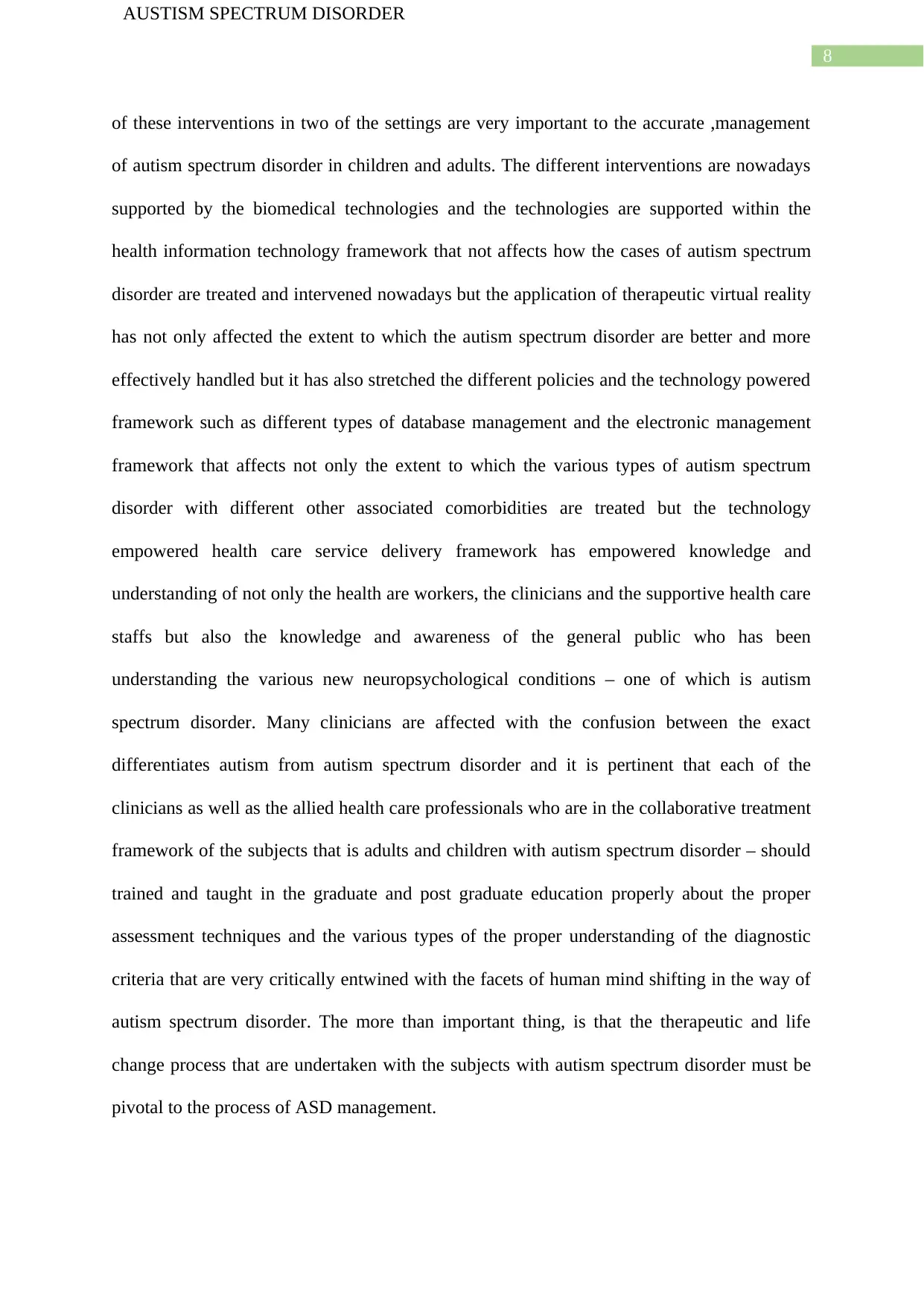
8
AUSTISM SPECTRUM DISORDER
of these interventions in two of the settings are very important to the accurate ,management
of autism spectrum disorder in children and adults. The different interventions are nowadays
supported by the biomedical technologies and the technologies are supported within the
health information technology framework that not affects how the cases of autism spectrum
disorder are treated and intervened nowadays but the application of therapeutic virtual reality
has not only affected the extent to which the autism spectrum disorder are better and more
effectively handled but it has also stretched the different policies and the technology powered
framework such as different types of database management and the electronic management
framework that affects not only the extent to which the various types of autism spectrum
disorder with different other associated comorbidities are treated but the technology
empowered health care service delivery framework has empowered knowledge and
understanding of not only the health are workers, the clinicians and the supportive health care
staffs but also the knowledge and awareness of the general public who has been
understanding the various new neuropsychological conditions – one of which is autism
spectrum disorder. Many clinicians are affected with the confusion between the exact
differentiates autism from autism spectrum disorder and it is pertinent that each of the
clinicians as well as the allied health care professionals who are in the collaborative treatment
framework of the subjects that is adults and children with autism spectrum disorder – should
trained and taught in the graduate and post graduate education properly about the proper
assessment techniques and the various types of the proper understanding of the diagnostic
criteria that are very critically entwined with the facets of human mind shifting in the way of
autism spectrum disorder. The more than important thing, is that the therapeutic and life
change process that are undertaken with the subjects with autism spectrum disorder must be
pivotal to the process of ASD management.
AUSTISM SPECTRUM DISORDER
of these interventions in two of the settings are very important to the accurate ,management
of autism spectrum disorder in children and adults. The different interventions are nowadays
supported by the biomedical technologies and the technologies are supported within the
health information technology framework that not affects how the cases of autism spectrum
disorder are treated and intervened nowadays but the application of therapeutic virtual reality
has not only affected the extent to which the autism spectrum disorder are better and more
effectively handled but it has also stretched the different policies and the technology powered
framework such as different types of database management and the electronic management
framework that affects not only the extent to which the various types of autism spectrum
disorder with different other associated comorbidities are treated but the technology
empowered health care service delivery framework has empowered knowledge and
understanding of not only the health are workers, the clinicians and the supportive health care
staffs but also the knowledge and awareness of the general public who has been
understanding the various new neuropsychological conditions – one of which is autism
spectrum disorder. Many clinicians are affected with the confusion between the exact
differentiates autism from autism spectrum disorder and it is pertinent that each of the
clinicians as well as the allied health care professionals who are in the collaborative treatment
framework of the subjects that is adults and children with autism spectrum disorder – should
trained and taught in the graduate and post graduate education properly about the proper
assessment techniques and the various types of the proper understanding of the diagnostic
criteria that are very critically entwined with the facets of human mind shifting in the way of
autism spectrum disorder. The more than important thing, is that the therapeutic and life
change process that are undertaken with the subjects with autism spectrum disorder must be
pivotal to the process of ASD management.
⊘ This is a preview!⊘
Do you want full access?
Subscribe today to unlock all pages.

Trusted by 1+ million students worldwide
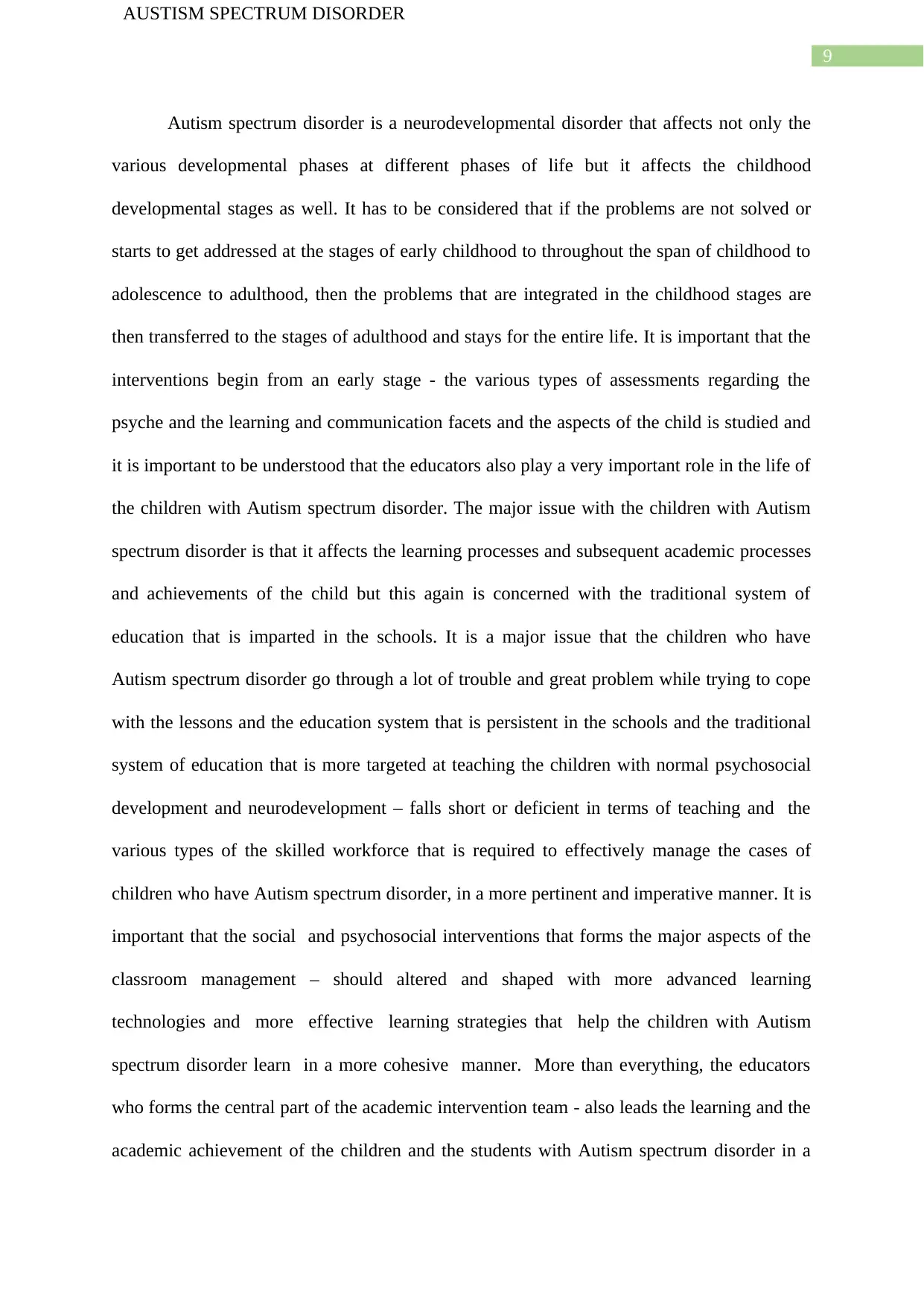
9
AUSTISM SPECTRUM DISORDER
Autism spectrum disorder is a neurodevelopmental disorder that affects not only the
various developmental phases at different phases of life but it affects the childhood
developmental stages as well. It has to be considered that if the problems are not solved or
starts to get addressed at the stages of early childhood to throughout the span of childhood to
adolescence to adulthood, then the problems that are integrated in the childhood stages are
then transferred to the stages of adulthood and stays for the entire life. It is important that the
interventions begin from an early stage - the various types of assessments regarding the
psyche and the learning and communication facets and the aspects of the child is studied and
it is important to be understood that the educators also play a very important role in the life of
the children with Autism spectrum disorder. The major issue with the children with Autism
spectrum disorder is that it affects the learning processes and subsequent academic processes
and achievements of the child but this again is concerned with the traditional system of
education that is imparted in the schools. It is a major issue that the children who have
Autism spectrum disorder go through a lot of trouble and great problem while trying to cope
with the lessons and the education system that is persistent in the schools and the traditional
system of education that is more targeted at teaching the children with normal psychosocial
development and neurodevelopment – falls short or deficient in terms of teaching and the
various types of the skilled workforce that is required to effectively manage the cases of
children who have Autism spectrum disorder, in a more pertinent and imperative manner. It is
important that the social and psychosocial interventions that forms the major aspects of the
classroom management – should altered and shaped with more advanced learning
technologies and more effective learning strategies that help the children with Autism
spectrum disorder learn in a more cohesive manner. More than everything, the educators
who forms the central part of the academic intervention team - also leads the learning and the
academic achievement of the children and the students with Autism spectrum disorder in a
AUSTISM SPECTRUM DISORDER
Autism spectrum disorder is a neurodevelopmental disorder that affects not only the
various developmental phases at different phases of life but it affects the childhood
developmental stages as well. It has to be considered that if the problems are not solved or
starts to get addressed at the stages of early childhood to throughout the span of childhood to
adolescence to adulthood, then the problems that are integrated in the childhood stages are
then transferred to the stages of adulthood and stays for the entire life. It is important that the
interventions begin from an early stage - the various types of assessments regarding the
psyche and the learning and communication facets and the aspects of the child is studied and
it is important to be understood that the educators also play a very important role in the life of
the children with Autism spectrum disorder. The major issue with the children with Autism
spectrum disorder is that it affects the learning processes and subsequent academic processes
and achievements of the child but this again is concerned with the traditional system of
education that is imparted in the schools. It is a major issue that the children who have
Autism spectrum disorder go through a lot of trouble and great problem while trying to cope
with the lessons and the education system that is persistent in the schools and the traditional
system of education that is more targeted at teaching the children with normal psychosocial
development and neurodevelopment – falls short or deficient in terms of teaching and the
various types of the skilled workforce that is required to effectively manage the cases of
children who have Autism spectrum disorder, in a more pertinent and imperative manner. It is
important that the social and psychosocial interventions that forms the major aspects of the
classroom management – should altered and shaped with more advanced learning
technologies and more effective learning strategies that help the children with Autism
spectrum disorder learn in a more cohesive manner. More than everything, the educators
who forms the central part of the academic intervention team - also leads the learning and the
academic achievement of the children and the students with Autism spectrum disorder in a
Paraphrase This Document
Need a fresh take? Get an instant paraphrase of this document with our AI Paraphraser
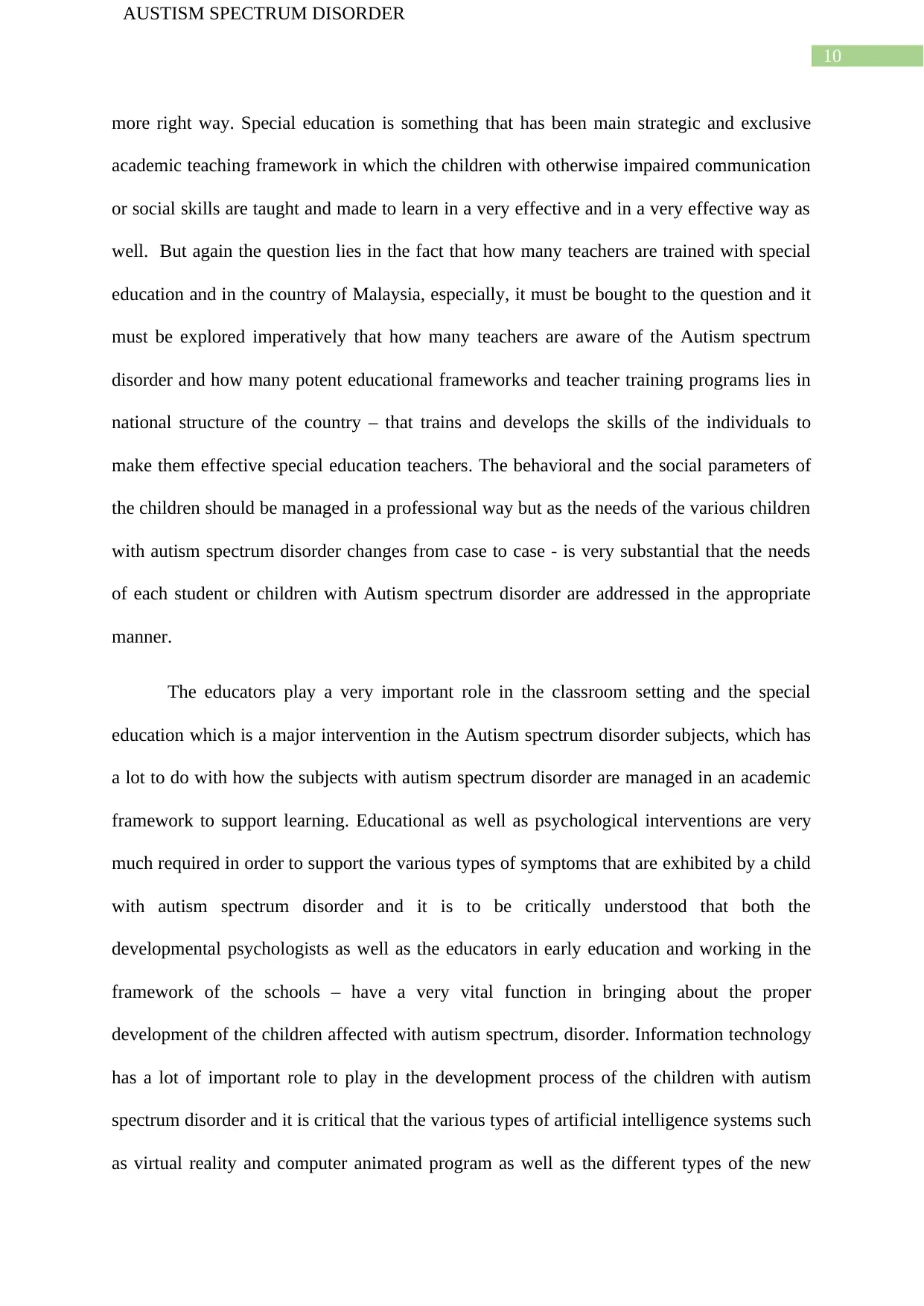
10
AUSTISM SPECTRUM DISORDER
more right way. Special education is something that has been main strategic and exclusive
academic teaching framework in which the children with otherwise impaired communication
or social skills are taught and made to learn in a very effective and in a very effective way as
well. But again the question lies in the fact that how many teachers are trained with special
education and in the country of Malaysia, especially, it must be bought to the question and it
must be explored imperatively that how many teachers are aware of the Autism spectrum
disorder and how many potent educational frameworks and teacher training programs lies in
national structure of the country – that trains and develops the skills of the individuals to
make them effective special education teachers. The behavioral and the social parameters of
the children should be managed in a professional way but as the needs of the various children
with autism spectrum disorder changes from case to case - is very substantial that the needs
of each student or children with Autism spectrum disorder are addressed in the appropriate
manner.
The educators play a very important role in the classroom setting and the special
education which is a major intervention in the Autism spectrum disorder subjects, which has
a lot to do with how the subjects with autism spectrum disorder are managed in an academic
framework to support learning. Educational as well as psychological interventions are very
much required in order to support the various types of symptoms that are exhibited by a child
with autism spectrum disorder and it is to be critically understood that both the
developmental psychologists as well as the educators in early education and working in the
framework of the schools – have a very vital function in bringing about the proper
development of the children affected with autism spectrum, disorder. Information technology
has a lot of important role to play in the development process of the children with autism
spectrum disorder and it is critical that the various types of artificial intelligence systems such
as virtual reality and computer animated program as well as the different types of the new
AUSTISM SPECTRUM DISORDER
more right way. Special education is something that has been main strategic and exclusive
academic teaching framework in which the children with otherwise impaired communication
or social skills are taught and made to learn in a very effective and in a very effective way as
well. But again the question lies in the fact that how many teachers are trained with special
education and in the country of Malaysia, especially, it must be bought to the question and it
must be explored imperatively that how many teachers are aware of the Autism spectrum
disorder and how many potent educational frameworks and teacher training programs lies in
national structure of the country – that trains and develops the skills of the individuals to
make them effective special education teachers. The behavioral and the social parameters of
the children should be managed in a professional way but as the needs of the various children
with autism spectrum disorder changes from case to case - is very substantial that the needs
of each student or children with Autism spectrum disorder are addressed in the appropriate
manner.
The educators play a very important role in the classroom setting and the special
education which is a major intervention in the Autism spectrum disorder subjects, which has
a lot to do with how the subjects with autism spectrum disorder are managed in an academic
framework to support learning. Educational as well as psychological interventions are very
much required in order to support the various types of symptoms that are exhibited by a child
with autism spectrum disorder and it is to be critically understood that both the
developmental psychologists as well as the educators in early education and working in the
framework of the schools – have a very vital function in bringing about the proper
development of the children affected with autism spectrum, disorder. Information technology
has a lot of important role to play in the development process of the children with autism
spectrum disorder and it is critical that the various types of artificial intelligence systems such
as virtual reality and computer animated program as well as the different types of the new
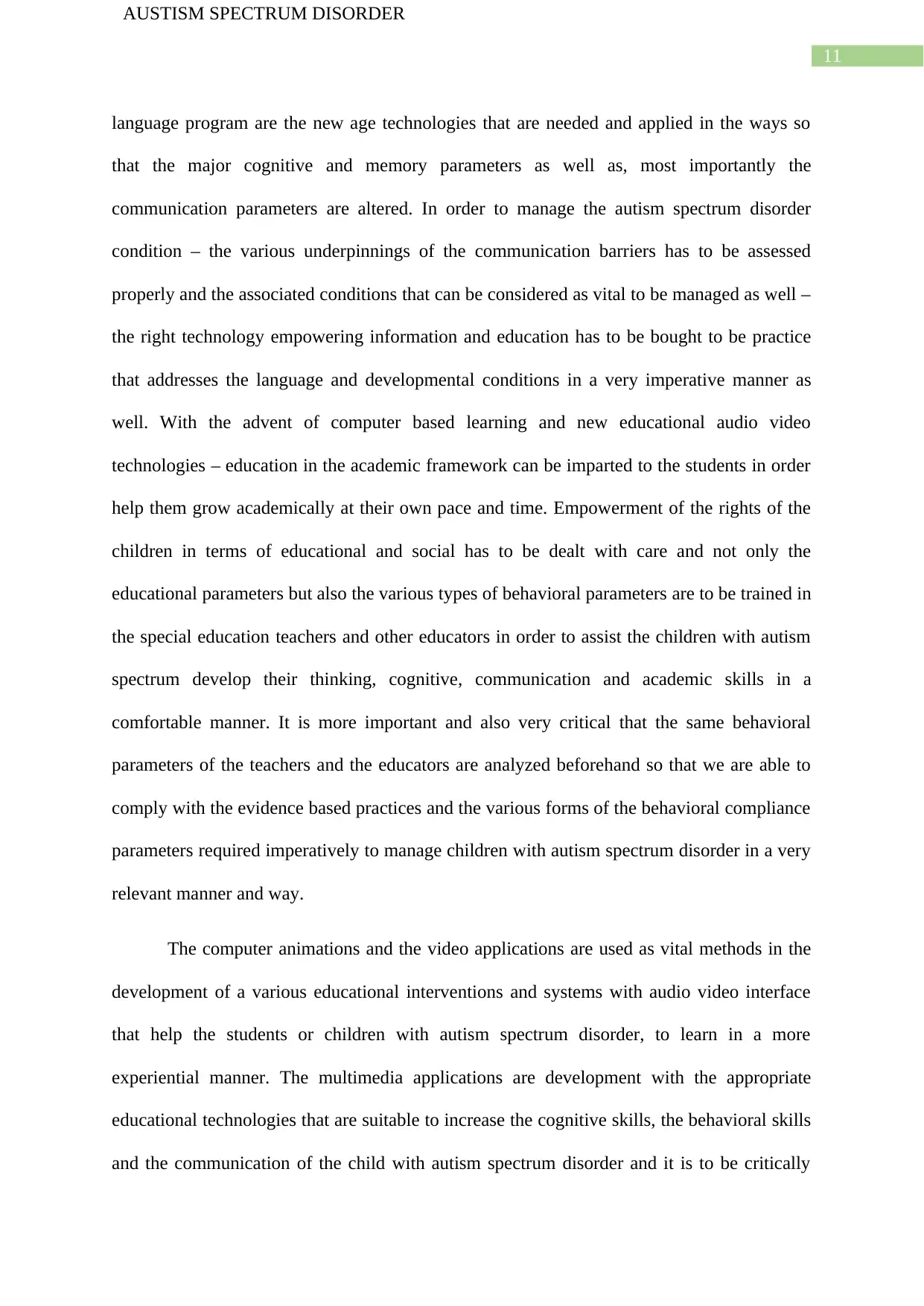
11
AUSTISM SPECTRUM DISORDER
language program are the new age technologies that are needed and applied in the ways so
that the major cognitive and memory parameters as well as, most importantly the
communication parameters are altered. In order to manage the autism spectrum disorder
condition – the various underpinnings of the communication barriers has to be assessed
properly and the associated conditions that can be considered as vital to be managed as well –
the right technology empowering information and education has to be bought to be practice
that addresses the language and developmental conditions in a very imperative manner as
well. With the advent of computer based learning and new educational audio video
technologies – education in the academic framework can be imparted to the students in order
help them grow academically at their own pace and time. Empowerment of the rights of the
children in terms of educational and social has to be dealt with care and not only the
educational parameters but also the various types of behavioral parameters are to be trained in
the special education teachers and other educators in order to assist the children with autism
spectrum develop their thinking, cognitive, communication and academic skills in a
comfortable manner. It is more important and also very critical that the same behavioral
parameters of the teachers and the educators are analyzed beforehand so that we are able to
comply with the evidence based practices and the various forms of the behavioral compliance
parameters required imperatively to manage children with autism spectrum disorder in a very
relevant manner and way.
The computer animations and the video applications are used as vital methods in the
development of a various educational interventions and systems with audio video interface
that help the students or children with autism spectrum disorder, to learn in a more
experiential manner. The multimedia applications are development with the appropriate
educational technologies that are suitable to increase the cognitive skills, the behavioral skills
and the communication of the child with autism spectrum disorder and it is to be critically
AUSTISM SPECTRUM DISORDER
language program are the new age technologies that are needed and applied in the ways so
that the major cognitive and memory parameters as well as, most importantly the
communication parameters are altered. In order to manage the autism spectrum disorder
condition – the various underpinnings of the communication barriers has to be assessed
properly and the associated conditions that can be considered as vital to be managed as well –
the right technology empowering information and education has to be bought to be practice
that addresses the language and developmental conditions in a very imperative manner as
well. With the advent of computer based learning and new educational audio video
technologies – education in the academic framework can be imparted to the students in order
help them grow academically at their own pace and time. Empowerment of the rights of the
children in terms of educational and social has to be dealt with care and not only the
educational parameters but also the various types of behavioral parameters are to be trained in
the special education teachers and other educators in order to assist the children with autism
spectrum develop their thinking, cognitive, communication and academic skills in a
comfortable manner. It is more important and also very critical that the same behavioral
parameters of the teachers and the educators are analyzed beforehand so that we are able to
comply with the evidence based practices and the various forms of the behavioral compliance
parameters required imperatively to manage children with autism spectrum disorder in a very
relevant manner and way.
The computer animations and the video applications are used as vital methods in the
development of a various educational interventions and systems with audio video interface
that help the students or children with autism spectrum disorder, to learn in a more
experiential manner. The multimedia applications are development with the appropriate
educational technologies that are suitable to increase the cognitive skills, the behavioral skills
and the communication of the child with autism spectrum disorder and it is to be critically
⊘ This is a preview!⊘
Do you want full access?
Subscribe today to unlock all pages.

Trusted by 1+ million students worldwide
1 out of 35
Related Documents
Your All-in-One AI-Powered Toolkit for Academic Success.
+13062052269
info@desklib.com
Available 24*7 on WhatsApp / Email
![[object Object]](/_next/static/media/star-bottom.7253800d.svg)
Unlock your academic potential
Copyright © 2020–2025 A2Z Services. All Rights Reserved. Developed and managed by ZUCOL.




